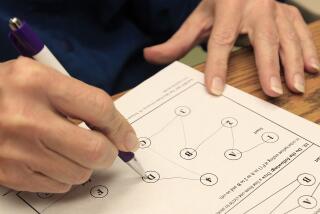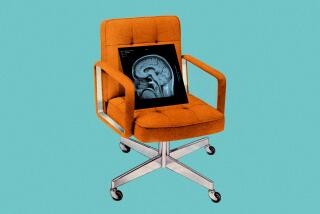New Test for Babies Aimed at Identifying Mental Risks
- Share via
ATLANTA — A test of how long infants look at patterns and faces can help identify children at risk of showing mental disability by age 3, a researcher says.
Early identification of high-risk children allows concentration of medical resources on the youngsters who need them and a way to quickly measure the impact of attempts to help a child’s development, researcher Joseph Fagan said.
The test should only be used on infants considered at risk, said Fagan, of Case Western Reserve University in Cleveland.
Such children include those treated in neonatal intensive care, those who suffered a breathing difficulty called respiratory distress syndrome, or those born well past their due dates.
No Rigorous Comparisons
Fagan described research on the test Monday at the annual meeting of the American Psychological Assn. Other researchers said that the test has not yet been rigorously compared to other methods for predicting mental difficulties and that it is not perfect.
The Fagan Test of Infant Intelligence relies on the fact that most babies look longer at new images than at familiar ones. That shows they can remember and discriminate between the images, reflecting two key abilities important for later life that are tapped by IQ tests, Fagan said.
The test presents infants with pairs of images, either faces or abstract designs. One is familiar, the other new. The time the infant spends looking at each image is precisely measured.
Infants who tend to look at each image in a given pair for about the same amount of time are considered at risk for later mental difficulties.
Accuracy of Test
Fagan cited research in which the test was given to infants 3 months to 7 months old who had been considered at risk. The predictions of the test were compared to the children’s IQ levels at age 3.
Of the 104 children predicted to be normal, 101 had normal intelligence at age 3. Of the 24 infants predicted to be at risk for mental difficulties, half had low IQ at age 3.
Fagan said most children who take the test because of some risk factor will receive a prediction of normality. So the test is valuable in relieving needless anxieties of parents, he said.
The test also will help research into whether exposure to certain substances early in life causes later mental troubles, because it shortens the time between exposure and detection of those troubles, he said.
Developer’s Royalty
Fagan said he receives a royalty on test kits sold by the corporation that markets the test.
Claire Kopp of UCLA said Fagan’s test has not yet been systematically compared for accuracy to other predictive techniques that focus on a child’s environment and parents, or development in such areas as language and perception.
Robert McCall, director of the University of Pittsburgh’s office of child development, said he and Fagan agree that the test should not be used as the sole means of diagnosing a problem. Rather, it should be part of a continuing process of observation by a professional, he said.
He also said that because mental disability is so rare even among infants thought to be at risk because of their histories, a flat prediction that they will all turn out fine will be correct 80% to 90% of the time.
Fagan’s test allows predicting normal outcome with 97% accuracy, however, and “I think that is useful,” McCall said.
But when the test predicts that an infant will turn out to be mentally disabled, it will be wrong at least half the time, he said. That causes needless heartbreak for the parents, he said, and parents without adequate support may give up on the child and adopt lowered expectations.






